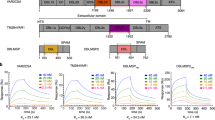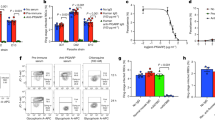Abstract
Apoptosis is conventionally regarded as an evolutionarily conserved and genetically controlled process of programmed cell death confined to metazoan organisms. However, recently, conserved features of apoptosis have also been demonstrated in unicellular eukaryotes (Holzmuller et al. Parasitology 132:S19–S32, 2006; Le Chat et al. Mol Biochem Parasitol 153:41–47, 2007; Madeo et al. Curr Opin Microbiol 7:655–660, 2004; Welburn et al. Parasitology 132:S7–S18, 2006; Jensen et al. Science 216:1230–1233, 1982) including malaria parasites (Al-Olayan et al. Int J Parasitol 32:1133–1143, 2002; Ch’ng et al. Cell Death Dis 1:e26, 2010; Meslin et al. J Infect Dis 195:1852–1859, 2007; Picot et al. Trans R Soc Trop Med Hyg 91:590–591, 1997; Raj et al. Nature 582:104–108, 2020). P. falciparum glutamic-acid-rich protein (PfGARP) is an antigen of 80 kDa that is uniquely expressed on the exofacial surface of red blood cells (RBCs) infected by early-to-late-trophozoite-stage P. falciparum parasites (Raj et al. Nature 582:104–108, 2020). We have recently demonstrated that antibodies against PfGARP bind to the PfGARP displayed on the surface of P. falciparum trophozoite-infected RBCs and trigger apoptosis in the intracellular parasites (Raj et al. Nature 582:104–108, 2020). This is the first demonstration of antibody-induced apoptosis in blood-stage malaria parasites and is characterized by several conserved features such as crisis form morphology, loss of mitochondrial membrane potential, loss of integrity of food vacuole, activation of caspase-like cysteine proteases, and fragmentation of chromosomal DNA. Here we describe the assays used to detect these features of apoptosis in the mature blood stage of malaria parasites.
Access this chapter
Tax calculation will be finalised at checkout
Purchases are for personal use only
Similar content being viewed by others
References
Ameisen JC (1996) The origin of programmed cell death. Science 272(5266):1278–1279. https://doi.org/10.1126/science.272.5266.1278
Holzmuller P, Bras-Goncalves R, Lemesre JL (2006) Phenotypical characteristics, biochemical pathways, molecular targets and putative role of nitric oxide-mediated programmed cell death in Leishmania. Parasitology 132(Suppl):S19–S32. https://doi.org/10.1017/S0031182006000837
Le Chat L, Sinden RE, Dessens JT (2007) The role of metacaspase 1 in Plasmodium berghei development and apoptosis. Mol Biochem Parasitol 153(1):41–47. https://doi.org/10.1016/j.molbiopara.2007.01.016
Madeo F, Herker E, Wissing S, Jungwirth H, Eisenberg T, Frohlich KU (2004) Apoptosis in yeast. Curr Opin Microbiol 7(6):655–660. https://doi.org/10.1016/j.mib.2004.10.012
Welburn SC, Macleod E, Figarella K, Duzensko M (2006) Programmed cell death in African trypanosomes. Parasitology 132(Suppl):S7–S18. https://doi.org/10.1017/S0031182006000825
Jensen JB, Boland MT, Akood M (1982) Induction of crisis forms in cultured Plasmodium falciparum with human immune serum from Sudan. Science 216(4551):1230–1233. https://doi.org/10.1126/science.7043736
Al-Olayan EM, Williams GT, Hurd H (2002) Apoptosis in the malaria protozoan, Plasmodium berghei: a possible mechanism for limiting intensity of infection in the mosquito. Int J Parasitol 32(9):1133–1143. https://doi.org/10.1016/s0020-7519(02)00087-5
Ch’ng JH, Kotturi SR, Chong AG, Lear MJ, Tan KS (2010) A programmed cell death pathway in the malaria parasite Plasmodium falciparum has general features of mammalian apoptosis but is mediated by clan CA cysteine proteases. Cell Death Dis 1:e26. https://doi.org/10.1038/cddis.2010.2
Meslin B, Barnadas C, Boni V, Latour C, De Monbrison F, Kaiser K, Picot S (2007) Features of apoptosis in Plasmodium falciparum erythrocytic stage through a putative role of PfMCA1 metacaspase-like protein. J Infect Dis 195(12):1852–1859. https://doi.org/10.1086/518253
Picot S, Burnod J, Bracchi V, Chumpitazi BF, Ambroise-Thomas P (1997) Apoptosis related to chloroquine sensitivity of the human malaria parasite Plasmodium falciparum. Trans R Soc Trop Med Hyg 91(5):590–591. https://doi.org/10.1016/s0035-9203(97)90039-0
Raj DK, Das Mohapatra A, Jnawali A, Zuromski J, Jha A, Cham-Kpu G, Sherman B, Rudlaff RM, Nixon CE, Hilton N, Oleinikov AV, Chesnokov O, Merritt J, Pond-Tor S, Burns L, Jolly G, Ben Mamoun C, Kabyemela E, Muehlenbachs A, Lambert L, Orr-Gonzalez S, Gnadig NF, Fidock DA, Park S, Dvorin JD, Pardi N, Weissman D, Mui BL, Tam YK, Friedman JF, Fried M, Duffy PE, Kurtis JD (2020) Anti-PfGARP activates programmed cell death of parasites and reduces severe malaria. Nature 582(7810):104–108. https://doi.org/10.1038/s41586-020-2220-1
Luder CG, Gross U, Lopes MF (2001) Intracellular protozoan parasites and apoptosis: diverse strategies to modulate parasite-host interactions. Trends Parasitol 17(10):480–486. https://doi.org/10.1016/s1471-4922(01)02016-5
Vaux DL, Strasser A (1996) The molecular biology of apoptosis. Proc Natl Acad Sci U S A 93(6):2239–2244. https://doi.org/10.1073/pnas.93.6.2239
Williams GT (1994) Programmed cell death: a fundamental protective response to pathogens. Trends Microbiol 2(12):463–464. https://doi.org/10.1016/0966-842x(94)90648-3
Deponte M, Becker K (2004) Plasmodium falciparum--do killers commit suicide? Trends Parasitol 20(4):165–169. https://doi.org/10.1016/j.pt.2004.01.012
Lambros C, Vanderberg JP (1979) Synchronization of plasmodium falciparum erythrocytic stages in culture. J Parasitol 65(3):418–420. https://doi.org/10.2307/3280287
Seligman AM, Wasserkrug HL, Hanker JS (1966) A new staining method (OTO) for enhancing contrast of lipid--containing membranes and droplets in osmium tetroxide--fixed tissue with osmiophilic thiocarbohydrazide(TCH). J Cell Biol 30(2):424–432. https://doi.org/10.1083/jcb.30.2.424
Deerinck TJ, Bushong EA, Lev-Ram V, Shu X, Tsien RY, Ellisman MH (2010) Enhancing serial block-face scanning electron microscopy to enable high resolution 3-D nanohistology of cells and tissues. Microsc Microanal 16(S2):1138–1139. https://doi.org/10.1017/s1431927610055170
Acknowledgments
This work was supported by grants from the US NIH (R01-AI076353, R01-AI127699, and R01-AI110699) and an internal Rhode Island Hospital Research Pilot Award grant to J.D.K.
Author information
Authors and Affiliations
Corresponding author
Editor information
Editors and Affiliations
Rights and permissions
Copyright information
© 2022 The Author(s), under exclusive license to Springer Science+Business Media, LLC, part of Springer Nature
About this protocol
Cite this protocol
Mohapatra, A.D., Zuromski, J., Kurtis, J. (2022). Assessing PfGARP-Mediated Apoptosis of Blood-Stage Plasmodium falciparum Parasites. In: Jensen, A.T.R., Hviid, L. (eds) Malaria Immunology. Methods in Molecular Biology, vol 2470. Humana, New York, NY. https://doi.org/10.1007/978-1-0716-2189-9_49
Download citation
DOI: https://doi.org/10.1007/978-1-0716-2189-9_49
Published:
Publisher Name: Humana, New York, NY
Print ISBN: 978-1-0716-2188-2
Online ISBN: 978-1-0716-2189-9
eBook Packages: Springer Protocols




